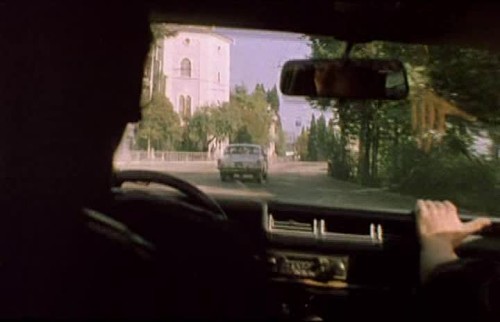  I’m not sure what the filmmakers were thinking of when they made this car chase scene in “Vory v Zakone†(1988). Gangster #1 (played by Valentin Gaft) has his driver take off at high speed after Gangster #2, who tries to get away.
 I’m not sure what the filmmakers were thinking of when they made this car chase scene in “Vory v Zakone†(1988). Gangster #1 (played by Valentin Gaft) has his driver take off at high speed after Gangster #2, who tries to get away.
 Gangster #1’s girlfriend, Rita, was in his car when he started, so after getting up to speed he stops the car to interrupt the pursuit and let her out, tell her he loves her (in none-too-speedy a fashion) and then resume the chase.
Gangster #1’s girlfriend, Rita, was in his car when he started, so after getting up to speed he stops the car to interrupt the pursuit and let her out, tell her he loves her (in none-too-speedy a fashion) and then resume the chase.
 Amazingly,Gangster #2 didn’t use the interruption to lose Gangster #1, because immediately thereafter Gangster Gaft sans girlfriend is is still on his tail, and the usual sort of mahem ensues (including running over a baby in a carriage).
Amazingly,Gangster #2 didn’t use the interruption to lose Gangster #1, because immediately thereafter Gangster Gaft sans girlfriend is is still on his tail, and the usual sort of mahem ensues (including running over a baby in a carriage).
This wasn’t a slow-speed comedy chase like the one in Eldar Ryazanov’s “Beware the Car.â€
Maybe the explanation is in parts I couldn’t understand, which is a lot of them.
Rita (played by Anna Vladlenovna Samokhina) later betrays Gaft’s gangster character, but I don’t think it’s in revenge for such an awkwardly-put-together scene.
I wonder if this 1988 film was the first of the long run of violent Russian gangster movies about the post-Soviet days, mostly tiresome ones. I can’t think of an earlier one of this genre.
The title can be literally translated as “Thieves in Law.â€Â I gather from the Wikipedia Article, “Thief in Law,†that this title phrase itself goes back a lot further than the modern gangster/mafia-type days. (The “talk†page is perhaps more interesting and informative than the article itself.) Given the role of the militia and procurator in the film, I thought it might in this case be referring to the corrupt entanglement of the police/legal system and the criminal establishment outside the prison system, even though the original “Thief in Law†phrase seems to have referred to criminals within the prison system.